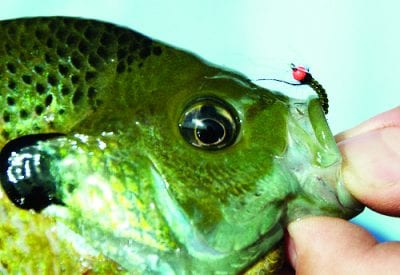by Mike Buss, Virginia Coastal Fly Anglers
This month we will continue our series of fly fishing friendly fishes by concentrating on freshwater panfish and bluegills in particular. Many of us got our start fly fishing by targeting these fish primarily because they can be found in a wide variety of waters and when found will readily take a fly.
Just about any fly that looks buggy will take panfish, but I like bluegills best because they will also readily take a top water popper and they put up a very spirited fight. In fact, if they got any larger they would be almost impossible to land because they’re such fighters. All you need to do is walk around any pond at twilight and listen to all the slurps and splashes taking place as bluegill after bluegill attacks another top water bug. I have spent many pleasurable hours casting top water poppers to bluegills and getting strikes on almost every cast. Most of the time these fish will be the size of your hand. If you want to catch the big bull bluegills, you need to go deep because that is where they live and that means using sinking lines or at least a sink tip line.
Bluegills can be found in a wide variety of waters, but if you want to target waters that hold big fish you need to look for water that is rich in nutrients and produces microscopic life that supports a food chain that will support all stages of bluegill life. You can tell water has good nutrient level if it is murky as opposed to being clear. Good bluegill waters also have abundant shallow water and vegetation. Lots of a wide variety of weeds provides ample protection for Bluegill fry and plenty of food and feeding opportunities through all stages of their life. They also like warm water temperatures and are most comfortable in water between sixty-five and eighty degrees. The presence of woody structure is also a bluegill magnet.
Bluegills typically spawn a couple of times a year in this area and will quickly overload a lake or pond with lots of stunted fish without a good supply of predator fish. Largemouth bass in good numbers do a real good job of keeping the bluegill population in check. Any good bluegill water will also be a pretty good largemouth bass lake. Good bluegill water will usually have gently sloping banks because there will usually be a lot of shallow water as a result. The more of these characteristics you find, the more likely you will be fishing in a lake, pond or river that will hold good numbers of big bluegills.
I like to use a 5 or 6 weight balanced outfit. If I am planning on using top water poppers, I will use a weight forward floating line. If I am going after the big ones I will use a sinking line to get down to them and use a count down system to make sure my flies get down to them. I normally use leaders with ten-pound test tippets. I’ve found small blue poppers work very well and just about anything that looks buggy and nymph like will work when fishing deep. When fishing poppers, I like to cast to rising fish. If I can get my popper close I usually get an immediate strike. If I don’t, I let the popper rest before giving it a twitch and let it rest again. I retrieve it in this pause, twitch pattern all the way back or until I see another rise to make another cast.
If I am fishing down deep, I look for an area with some structure and then make a cast with my sinking line. It’s important to know how fast your line will sink so you know the depth your fly is reaching. I usually start at the five or six-foot level and keep letting my fly sink deeper on each cast until I connect with fish. Then I count my fly down to the same level until I stop getting strikes.
These fish are a lot of fun to catch and put up a very tough fight, plus they swim in almost all of our local waters so you don’t need to travel far to find them.
Good luck and tight lines.
